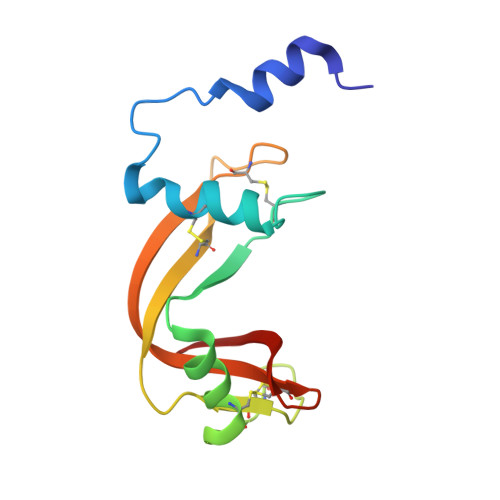Mapping the ribonucleolytic active site of bovine seminal ribonuclease. The binding of pyrimidinyl phosphonucleotide inhibitors
Dossi, K., Tsirkone, V.G., Hayes, J.M., Matousek, J., Pouckova, P., Soucek, J., Zadinova, M., Zographos, S.E., Leonidas, D.D.(2009) Eur J Med Chem 44: 4496-4508
- PubMed: 19643512
- DOI: https://doi.org/10.1016/j.ejmech.2009.06.039
- Primary Citation of Related Structures:
3DJO, 3DJP, 3DJQ, 3DJV, 3DJX - PubMed Abstract:
Bovine seminal ribonuclease (BS-RNase) is a 27kDa homodimeric enzyme and a member of the pancreatic RNase A superfamily. It is the only RNase with a quaternary structure and it is a mixture of two dimeric forms. In the most abundant form the active site is formed by the swapping of the N-terminal segments. BS-RNase is a potent antitumor agent with severe side effects such as aspermatogenicity, and immunosuppression. As a first step towards the design of potent inhibitors of this enzyme we mapped its active site through the study of the binding of uridine 2'-phosphate (U2'p), uridine 3'-phosphate (U3'p), uridine 5'-diphosphate (UDP), cytidine 3'-phosphate (C3'p), and cytidine 5-phosphate (C5'p), by kinetics, and X-ray crystallography. These phosphonucleotides are potent inhibitors with C3'p being the most potent with a K(i) value of 22 microM. Absorption, distribution, metabolism, and excretion pharmacokinetic property predictions reveal U2'p, U3'p, and C5'p as the most promising with respect to oral bioavailability. In vivo studies on the aspermatogenic effect have shown that C3'p and C5'p inhibit significantly this biological action of BS-RNase.
- Institute of Organic and Pharmaceutical Chemistry, National Hellenic Research Foundation, 48 Vas. Constantinou Avenue, 11635 Athens, Greece.
Organizational Affiliation:

















